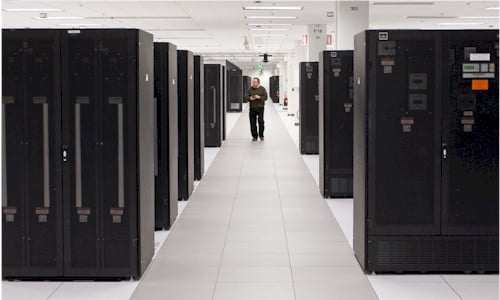Original URL: https://www.theregister.com/2010/02/09/ibm_rtp_data_center/
IBM chills sealed data center with outside air
Ambient air water tank cooling
Posted in Channel, 9th February 2010 22:21 GMT
If you want to be a player in cloud computing, you have to build data centers. Server maker IBM probably thinks it will sell a lot more internal cloud than external cloud, but it realized that customers will want a mix of public and hosted cloud infrastructure to run their workloads. Hence, IBM has shelled out $362m to build a data center in Research Triangle Park, North Carolina, a facility dedicated to supporting customers who want to use Big Blue's CloudBurst cloud services.
IBM owns more than 450 data centers worldwide, and it has more than 8 million square feet of raised floor data center space under its management, according to Joe Dzaluk, vice president of infrastructure at the company's Global Technology Services division. So while this new data center in Carolina will eventually scale to over 100,000 square feet - fairly large by data center standards - it is but a drop in the Big Blue bucket.
The company started construction of the RTP data center back in August 2008 and had people moving in gear in 15 months, compared to the 18 to 24 months it usually takes, says Dzaluk. IBM took an existing facility and renovated it rather than building a new structure, keeping 95 per cent of the original building's shell and recycling 90 per cent of the stuff it ripped out.
In keeping with its green theme, 20 percent of the materials used to upgrade the facility came from recycled products. The carbon footprint associated with the construction of the data center was 50 per cent lower than it might have been had Big Blue just raised a new building from scratch, which helped it get the LEED Gold data center certification that green-washing IT vendors and companies with big data centers all chase for PR as well as economic and technical reasons.
In the first phase of the RTP data center, IBM has 60,000 square feet with raised floor and can draw on 6 megawatts of power. There is a separate 40,000 of additional space will eventually be activated as IBM adds cloud customers, and the facility can draw as much as 15 megawatts. The modular design IBM has chosen will allow it to bring new capacity online in about half the time, the company says.
It did not elaborate about how this calculation was arrived at, but clearly, it takes less time to put in a floor in a pre-made shell than it does to build an add-on to a an existing data center. Basically, IBM seems to have left 40 per cent of the data center unfinished, which obviously saves money and allows that 40 percent to be finished in pieces or all at once as conditions dictate.
The RTP data center has been equipped with 2,000 sensors for the air conditioning units to gather up data on weather conditions in the facility - temperature, pressure, humidity, and air flow - and IBM Research has come up with some software that will no doubt be productized that will be used by Big Blue to move workloads around the data center as weather conditions change to keep hot spots from developing. In total, the data center, its power distribution, and air conditioning units have over 30,000 sensors that this data center management software can make use of to move workloads around.
Air-cooled water tanks
Data center operators are starting to use ambient cooling - letting outside air in when it is cool enough instead of running air conditioners - to keep the machinery in the data center from overheating. The RTP data center is a sealed box, like a traditional data center, but there's a different twist. IBM has installed three large tanks with water, which are chilled by the outside air when the weather is cool enough. Dzaluk reckons that IBM can get free cooling about 50 per cent of the time over the course of a year using the water tank scheme.
This chilled outside water is used in addition to variable speed CRAC units to provide cool air and water in the data center. For areas in the data center where thermal densities are above 150 watts per square foot, water cooling can be brought directly to the rack. In some cases, the thermal densities will be 10 to 20 times this level, according to Dzaluk.

Data centers are like airports. Can you tell which one you are in?
Right now, the RTP data center has eight paying customers, not including IBM's own Web site, ibm.com, which has about a third of its operations there. (IBM spreads its Web site across three data centers). IBM is also hosting its CloudBurst development and virtual PC cloud offerings there. The current non-IBM clients are all using IBM's iDataPlex hybrid x64 servers, which are a cross between rack and blade machines, but Dzaluk says that very soon IBM's customers will be installing Power7-based Power Systems machines as well as System z mainframes to support cloud projects.
About half of the data center's 1,000 racks of space in the first phase has already been booked, and Dzaluk says that eventually somewhere around 40 to 50 distinct customers will host their cloud applications in the facility.
Most of that $362m, by the way, is for the IT iron. According to Dzaluk, the physical data center itself is "not a big cost" compared to the price of the hardware and software that runs inside of the shell. It would seem that what data centers need are less expensive IT as well as better data centers. But to suggest that is, of course, heresy to IT vendors that want to preserve revenue streams and keep riding Moore's Law to boost capacity every two years or so. ®